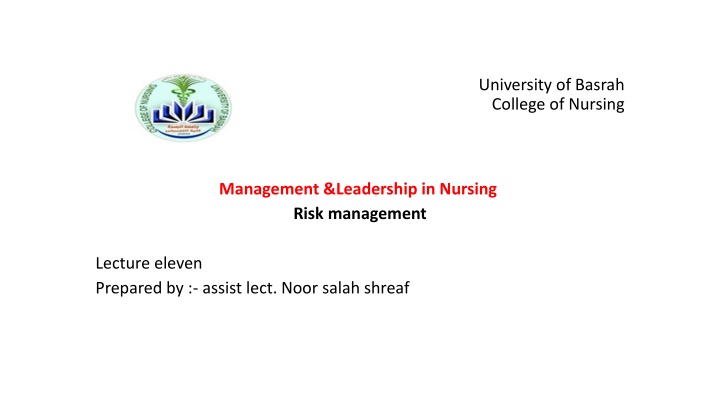
Effective Risk Management Strategies for Organizations
Understand the significance of risk management in nursing management and leadership. Learn how to identify, assess, and control various risks to safeguard your organization's capital and earnings. Discover the importance of risk management in handling financial uncertainties, legal liabilities, strategic errors, accidents, and natural disasters. Explore the key steps in the risk management process, including risk identification, analysis, mitigation, and monitoring. Gain insights into common risk response strategies such as risk avoidance, reduction, sharing, transferring, and acceptance.
Download Presentation

Please find below an Image/Link to download the presentation.
The content on the website is provided AS IS for your information and personal use only. It may not be sold, licensed, or shared on other websites without obtaining consent from the author. If you encounter any issues during the download, it is possible that the publisher has removed the file from their server.
You are allowed to download the files provided on this website for personal or commercial use, subject to the condition that they are used lawfully. All files are the property of their respective owners.
The content on the website is provided AS IS for your information and personal use only. It may not be sold, licensed, or shared on other websites without obtaining consent from the author.
E N D
Presentation Transcript
University of Basrah College of Nursing Management &Leadership in Nursing Risk management Lecture eleven Prepared by :- assist lect. Noor salah shreaf
What is risk management? Risk management is the process of identifying, assessing and controlling financial, legal, strategic and security risks to an organization s capital and earnings.
Importance of risk management: These threats or risks, could stem from a wide variety of sources, including: 1. Financial uncertainty 2. Legal liabilities 3. Strategic management errors 4. Accidents 5. Natural disasters.
If an unforeseen event catches your organization unaware, the impact could be: 1. Minor, such as a small impact on your overhead costs. 2. Catastrophic, such as a significant financial burden or even the closure of your business. To reduce risk, an organization needs to apply resources to minimize, monitor and control the impact of negative events while maximizing positive events.
The risk management process Risk management is a system of people, processes and technology that enables an organization to establish objectives in line with values and risks. A successful risk assessment program must meet legal, contractual, internal, social and ethical goals, as well as monitor new technology- related regulations.
Three important steps of the risk management process are: 1. Risk identification Risk identification is the process of identifying and assessing threats to an organization, its operations and its workforce. 2. Risk analysis and assessment Risk analysis involves establishing the probability that a risk event might occur and the potential outcome of each event. 3. Risk mitigation and monitoring Risk mitigation refers to the process of planning and developing methods and options to reduce threats to project objectives.
Risk response strategies and treatment What are the most common responses to risk? 1. Risk avoidance 2. Risk reduction 3. Risk sharing 4. Transferring risk 5. Risk acceptance and retention
Limitations and risk management standards Risk management standards set out a specific set of strategic processes that start with the objectives of an organization and intend to identify risks and promote the mitigation of risks through best practice. While adopting a risk management standard has its advantages, it is not without challenges. The new standard might not easily fit into what you are doing already, so you could have to introduce new ways of working. The standards might need customizing to your industry or business.
